Alpes-Maritimes
Alpes-Maritimes (French: [alp(ə)maʁitim]; Occitan: Aups Maritims; Italian: Alpi Marittime, "Maritime Alps") is a department of France located in the extreme southeast corner of the country, on the border with Italy and on the Mediterranean coast. Part of the Provence-Alpes-Côte d'Azur region, it had a population of 1,083,310 in 2017.
Alpes-Maritimes | |
|---|---|
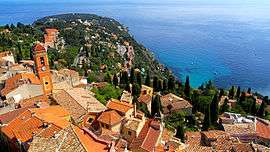    From top down, left to right: Roquebrune-Cap-Martin, Saint-Dalmas-le-Selvage, prefecture building in Nice and Mercantour National Park | |
 Flag 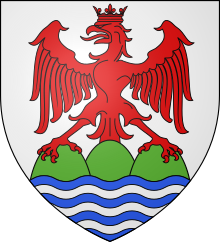 Coat of arms | |
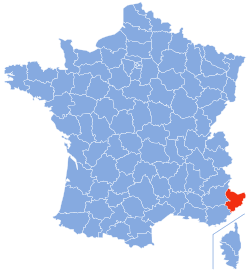 Location of Alpes-Maritimes in France | |
| Coordinates: 43°50′N 7°10′E | |
| Country | France |
| Region | Provence-Alpes-Côte d'Azur |
| Prefecture | Nice |
| Subprefectures | Grasse |
| Government | |
| • President of the Departmental Council | Charles-Ange Ginésy (LR) |
| Area | |
| • Total | 4,299 km2 (1,660 sq mi) |
| Population (2017) | |
| • Total | 1,083,310 |
| • Rank | 20th |
| • Density | 250/km2 (650/sq mi) |
| Time zone | UTC+1 (CET) |
| • Summer (DST) | UTC+2 (CEST) |
| Department number | 06 |
| Arrondissements | 2 |
| Cantons | 27 |
| Communes | 163 |
| ^1 French Land Register data, which exclude estuaries, and lakes, ponds, and glaciers larger than 1 km2 | |
It has become in recent years one of the world's most attractive destinations, featuring cities such as Nice, Cannes, Antibes and Grasse, and numerous alpine ski resorts. Alpes-Maritimes also entirely surrounds Monaco. The department's inhabitants are called Maralpins or Maralpines; it has the same flag and arms as the City of Nice.
Geography
Overview
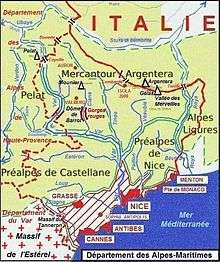
The Alpes-Maritimes department is surrounded by the departments of Var in the southwest, Alpes-de-Haute-Provence in the northwest, Italy to the north and east, and the Mediterranean Sea to the south. It surrounds the Principality of Monaco on the west, north and east.
Its topography is very mixed. As its name suggests, most of the department is a constituent part of the overall topographic Alps – including the Maritime Alps – but it also has the distinction of being a coastal district with its Mediterranean coast. The coastal area, urbanized and densely populated (shaded in red on the map), includes all the cities in an almost continuous conurbation from Cannes to Menton, while the larger but sparsely populated mountainous area (light green) is fully rural with the exception of the three large resorts of Valberg (created in 1936), Auron (created in 1937), and Isola 2000 (created in 1971).
Summits and passes
The highest point of the department is the Cime du Gélas (3,143 metres, 10,312 ft) on the Franco-Italian border which dominates the Vallée des Merveilles further east. The summit of Monte Argentera is higher at 3,297 metres (10,817 ft) above sea level, but it is located in Italy. There is also Mount Mounier (2,817 metres, 9,242 ft), which dominates the south of the vast Dôme de Barrot, formed of a mass more than 900 metres (3,000 ft) thick of red mudstones deeply indented by the gorges of Daluis and Cians. Except in winter, four passes allow passage to the north of the Mercantour/Argentera mountain range whose imposing 62-kilometre-long (39 mi) barrier is covered in winter snow which is visible from the coast. From the west, the Route des Grandes Alpes enters the Cayolle Pass (2,326 metres, 7,631 ft) first on the way to the Alps and the sources of the Var in the commune of Entraunes. Then the route follows the Col de la Bonette – the highest pass in Europe at 2,715 metres (8,907 ft) – to connect to the valley of the Tinée then the Ubaye. Further east, the Col de la Lombarde (2,350 metres, 7,710 ft) above Isola 2000 allows access to the shrine of Saint-Anne de Vinadio in Italy. Finally, at its eastern end, the Col de Tende (1,871 metres, 6,138 ft) links with Cuneo in Italy.
Landscape and forest vegetation
The only region of the Alps close to Nice has an afforestation rate of 60.9%, slightly higher than the average of the department and well above the average of 39.4% for the Provence-Alpes-Côte d'Azur region.[1]
The rivers in alphabetical order are:
- Aigue Blanche
- Barlatte
- Bassera
- Bendola
- Bévéra
- Borrigo
- Bourdoux
- Bouyon
- Brague
- Braisse
- Braus
- Cagne
- Caramagne
- Careï
- Castérine
- Chalvagne
- Cians
- Ciavanette
- Clans
- Coulomb
- Estéron
- Faye
- Fontanalbe
- Gorbio
- Gordolasque
- Guercha
- Levenza
- Loup
- Lubiane
- Maglia
- Magnan
- Mairole
- Malvan
- Minière
- Nieya
- Oglione
- Paillon (les Paillons)
- Raton
- Réfrei
- Riou
- Rioulan
- Roudoule
- Roya
- Siagne
- Tinée
- Tuébi
- Valmasque
- Var
- Vésubie
- Vionène
Climate
It is the climate that made the Côte d'Azur famous. The current department of Alpes-Maritimes, however, does not have only one climate, the complex terrain and high mountains divide the department between those who are well exposed (the south-facing side) and those which are less (the north-facing side) and even with the mild Mediterranean climate there can be violent storms and prolonged droughts.
The coastal area has a Mediterranean climate (rainfall in autumn and spring especially, summer drought, mild winter and dry). The interior, especially in the north, has a mountain climate (winter quite bright, summer storms). Around Cannes is a particularly warm micro-climate due to the high hills warming the air which descends on the city.
One of the attractions of the department is its level of sunshine: 300 days per year. Despite this the department is also the most stormy of France with an average of 70 to 110 thunderstorm days per year, arising from the differences in temperature due to a warm sea in autumn.
As soon as one moves away from the coast, towards the west of the department, the interior plains (in particular near Grasse) the climate is a little less temperate but just as sunny. In summer, the temperature very easily exceeds 30 °C (86 °F), while the average is only 27 °C (81 °F) on the Nice coast for July and August. Occasional frost is possible in winter when, unlike in Nice, were they are very rare.
In the east of the department, unlike the west, there are no plains. In the Menton region, the altitude increases very rapidly inland, so the sea tempers the atmosphere much more: the maximum in summer is on average 25 °C (77 °F) and the winters are milder than in the interior Frost is rare.
Snow is rare on the coast, however, it happens that good falls surprise the Côte d'Azur, as was the case in the winter of 2004-2005 when the city of Nice woke up with a few centimetres of snow, creating traffic problems. More recently, in February 2010, more than 10 centimetres (3.9 in) of snow was measured in Cannes and nearly 30 centimetres (12 in) in the Grasse region.
In the Alps the climate is mountainous, and there is snow from November to May.
| Climate data for Nice | |||||||||||||
|---|---|---|---|---|---|---|---|---|---|---|---|---|---|
| Month | Jan | Feb | Mar | Apr | May | Jun | Jul | Aug | Sep | Oct | Nov | Dec | Year |
| Average high °C (°F) | 13.1 (55.6) |
13.4 (56.1) |
15.2 (59.4) |
17.0 (62.6) |
20.7 (69.3) |
24.3 (75.7) |
27.3 (81.1) |
27.7 (81.9) |
24.6 (76.3) |
21.0 (69.8) |
16.6 (61.9) |
13.8 (56.8) |
19.6 (67.3) |
| Daily mean °C (°F) | 9.2 (48.6) |
9.7 (49.5) |
11.6 (52.9) |
13.6 (56.5) |
17.4 (63.3) |
20.9 (69.6) |
23.8 (74.8) |
24.2 (75.6) |
21.0 (69.8) |
17.4 (63.3) |
12.9 (55.2) |
10.1 (50.2) |
16.0 (60.8) |
| Average low °C (°F) | 5.3 (41.5) |
5.9 (42.6) |
7.9 (46.2) |
10.2 (50.4) |
14.1 (57.4) |
17.5 (63.5) |
20.3 (68.5) |
20.5 (68.9) |
17.3 (63.1) |
13.7 (56.7) |
9.2 (48.6) |
6.3 (43.3) |
12.4 (54.3) |
| Average precipitation mm (inches) | 69.0 (2.72) |
44.7 (1.76) |
38.7 (1.52) |
69.3 (2.73) |
44.6 (1.76) |
34.3 (1.35) |
12.1 (0.48) |
17.8 (0.70) |
73.1 (2.88) |
132.8 (5.23) |
103.9 (4.09) |
92.7 (3.65) |
733.0 (28.86) |
| Average precipitation days (≥ 1 mm) | 5.8 | 4.7 | 4.6 | 7.1 | 5.2 | 3.8 | 1.8 | 2.4 | 4.9 | 7.2 | 7.2 | 6.4 | 61.1 |
| Mean monthly sunshine hours | 158 | 171 | 217 | 224 | 267 | 306 | 348 | 316 | 242 | 187 | 149 | 139 | 2,724 |
| Source: Meteorological data for Nice – 2 m altitude, from 1981 to 2010 January 2015 (in French) | |||||||||||||
| Town | Sunshine (hours/yr) |
Rain (mm/yr) | Snow (days/yr) | Storm (days/yr) | Fog (days/yr) |
|---|---|---|---|---|---|
| National Average | 1,973 | 770 | 14 | 22 | 40 |
| Nice | 2,724 | 733 | 1 | 29 | 1 |
| Paris | 1,661 | 637 | 12 | 18 | 10 |
| Strasbourg | 1,693 | 665 | 29 | 29 | 56 |
| Brest | 1,605 | 1,211 | 7 | 12 | 75 |
Subdivisions

Alpes-Maritimes is divided into two arrondissements: Grasse and Nice, twenty-seven cantons and 163 communes.
As of 1 January 2014, there were seven intercommunalities:[3]
- Four agglomeration communities:
- Communauté d'agglomération de Sophia Antipolis
- Communauté d'agglomération Cannes Pays de Lérins
- Communauté d'agglomération du Pays de Grasse
- Communauté d'agglomération de la Riviera Française
- One metropolis:
- Two communautés de communes:
- Communauté de communes du Pays des Paillons
- Communauté de communes Alpes d'Azur
The most populous cities in the department in 2012 were:
- Nice (343,629)
- Antibes (75,568)
- Cannes (73,603)
- Grasse (51,021)
- Cagnes-sur-Mer (46,686)
- Le Cannet (43,115)
- Saint-Laurent-du-Var (29,343)
- Menton (29,073)
- Vallauris (26,595)
- Mandelieu-la-Napoule (22,714)
- Vence (19,241)
- Mougins (17,884)
History
| Historical population | ||
|---|---|---|
| Year | Pop. | ±% p.a. |
| 1806 | 131,266 | — |
| 1821 | 161,886 | +1.41% |
| 1851 | 192,062 | +0.57% |
| 1861 | 194,578 | +0.13% |
| 1872 | 199,037 | +0.21% |
| 1881 | 226,621 | +1.45% |
| 1891 | 258,571 | +1.33% |
| 1901 | 293,213 | +1.27% |
| 1911 | 356,338 | +1.97% |
| 1921 | 357,759 | +0.04% |
| 1931 | 493,376 | +3.27% |
| 1936 | 513,714 | +0.81% |
| 1946 | 453,073 | −1.25% |
| 1954 | 515,484 | +1.63% |
| 1962 | 618,265 | +2.30% |
| 1968 | 722,070 | +2.62% |
| 1975 | 816,681 | +1.77% |
| 1982 | 881,198 | +1.09% |
| 1990 | 971,829 | +1.23% |
| 1999 | 1,011,326 | +0.44% |
| 2006 | 1,073,184 | +0.85% |
| 2011 | 1,081,244 | +0.15% |
| 2016 | 1,083,704 | +0.05% |
| source:[5] | ||
The Roman military district of Alpes Maritimae was created by Augustus in 14 BC. It became a full Roman province in the middle of the 1st century AD, with its capital first at Cemenelum (today Cimiez, a suburb north of Nice) and subsequently at Embrun. At its greatest extent in AD 297, the province reached north to Digne and Briançon.
Conquered by the French First Republic during the French Revolutionary Wars, a department of Alpes-Maritimes was first set up in 1793 with different boundaries from those of the modern department. In 1793, Alpes-Maritimes included Monaco (Port Hercules), but not Grasse, which was then part of the department of Var as an historical part of France. In 1805, San Remo (San Rème) was included after the disbandment of the Ligurian Republic. In 1812, the department had three arrondissements with the following cantons:[6]
- Nice, cantons: Nice (2 cantons), Aspremont, La Brigue, Menton, Monaco, Roquebillière, Saint-Sauveur-sur-Tinée, Saorge, L'Escarène, Sospel, Utelle and Villefranche-sur-Mer.
- Sanremo, cantons: Sanremo, Bordighera, Dolceacqua, Pigna, Taggia, Triora and Ventimiglia.
- Puget-Théniers, cantons: Puget-Théniers, Beuil, Gilette, Guillaumes, Roquestéron, Saint-Étienne-de-Tinée and Villars-sur-Var.
The population of the department in 1812 was 131,266, and its area was 3,226.74 square kilometres (1,245.85 sq mi), covering both present-day Arrondissement of Nice, Principality of Monaco and Province of Imperia.[6]
In 1814, at the close of the Napoleonic Wars, the territory was restored to the Crown of Savoy by the Congress of Vienna.
In 1860 Camillo Benso, Count of Cavour, one of the architects of Italian unity with the Kingdom of Piedmont-Sardinia, negotiated support for Napoleon III in exchange for Savoy and the County of Nice as set forth in the Treaty of Turin. The annexation was confirmed on 15 and 16 April 1860 by 30,712 male electors enrolled in the 89 communes of the County of Nice who, for the first time, had universal male suffrage by plebiscite. The "Yes" vote for reunification with France was 83.8% of registered voters and 99.2% of votes.[7] The new department of Alpes-Maritimes consisted of the former County of Nice, divided into an Arrondissement of Nice and an Arrondissement of Puget-Théniers (both arrondissements existed in the former Department (1793–1814)), and a portion of the Var department, which formed the Arrondissement of Grasse. However, the County of Nice did not include Tende and La Brigue, which were still part of Piedmont-Sardinia.
For economic reasons, the Arrondissement of Puget-Théniers was merged into to the Arrondissement of Nice in 1926. Since that time, the department has had two arrondissements.
In 1947, in accordance with the Treaty of Paris and as a referendum result favourable to their attachment to France, the communes of Tende and La Brigue (also parts of communes in the high valleys of Vésubie and Tinée: part the commune of Isola) which had not been ceded to France in 1860, were attached to the department.
Heraldry
 Arms of Alpes-Maritimes and Nice |
Blazon: Argent, an eagle crowned of gules displayed with wings inverted, on a mountain of three hillocks sable issuant from the pointed waves of a sea azure waved in argent. |
Administration
Politics
Departmental Council of Alpes-Maritimes

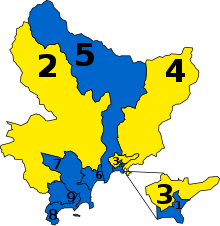
Since the Second World War, the department has voted to the right. It has nine constituencies for the National Assembly. Following the legislative election of 2017 six constituencies are represented by members of The Republicans (LR) right-wing party and three by the centrist La République En Marche! (REM) party. Of the five Senators representing the department in the Senate, four are right-wing (LR) and one is left-wing (Socialist Party, PS). Of the fifty-two departmental councilors, forty-two are right and ten are left.
Alpes-Maritimes has experienced problems of corruption in its politicians in the 1980s and 1990s which led to criminal convictions including the Mayors of Nice (Jacques Médecin), Cannes (Michel Mouillot) and Antibes (Pierre Merli, criminally indicted in 1995 for real estate scam and convicted in 1999).
The President of the Departmental Council is Charles-Ange Ginésy,[8] who succeeded Éric Ciotti in 2017. Both are members of The Republicans (LR) party. The LR majority in the departmental council is one of the largest majorities in any such institution in France.
| Party | Seats | |
|---|---|---|
| • | The Republicans | 38 |
| Socialist Party | 3 | |
| • | Miscellaneous right | 3 |
| French Communist Party | 3 | |
| Miscellaneous left | 2 | |
| The Greens | 1 | |
| Ecologist | 1 | |
| • | New Centre | 1 |
Members of the National Assembly
Alpes-Maritimes elected the following members of the National Assembly during the 2017 legislative election:
Budget
In 2011, the draft departmental budget amounted to €1.3 billion of which 498 million (38.3%) was devoted to social action and 346 million to operations (26.6%).[10] Capital expenditures was just over 250 million euros (19.2%).[10]
In 2010, the department was the third most indebted in France with €942 million of debt or 68.4% of the annual budget.[11] This debt amounted to 2,460 euros per fiscal tax unit (household) and 859 euros per person.[11] The trend of change in debt over the last decade has been a sharp increase: + 440% between 2001 and 2009 and 26% between 2009 and 2010.[11] There was only €43 million in debt in 2003.
Projects
The Departmental Council of Alpes-Maritimes is currently sponsoring several large projects:[12]
- construction of 10 residential facilities for the elderly
- building dikes in the Var plain
- creation of a STIC (science and information technology and communication) campus at Sophia Antipolis
- construction of 337 units of social housing
- establishment of facilities for the disabled
- road construction
- construction of schools and gyms (10)
- construction of a centre of sustainable development
- construction of the LGV Provence-Alpes-Côte d'Azur
- creation of the Eco Valley in the Plaine of the Var which will run from the Arena Quarter (which will be converted) to the village of Baus-Roux
The Alpes-Maritimes Departmental Council has charged 1 euro per vehicle journey in the department, regardless of distance, since 1 January 2008.
Demographics
When Nice became part of France in 1860, it was still a small town; the department had fewer than 200,000 inhabitants. However, the population grew quickly from 300,000 at the beginning of the 20th century to over a million. The population is aging because of the number of retirees who move to the coast.
The population is now concentrated in the urban region that includes Antibes, Cannes, Grasse, Nice, and Menton, and which constitutes 90% of the total population.
The department had 1,079,100 inhabitants in 2009, making it the nineteenth most populated department in France.[13] There are 163 communes including 106 under 2000 inhabitants (representing a total of 55,219 inhabitants), 38 from 2000 to 9999 inhabitants (total 158,373 inhabitants), 15 between 10,000 and 49,999 inhabitants (total 323,829 inhabitants), 3 between 50,000 and 199,999 inhabitants (Antibes, Cannes, and Grasse, total 200,944 inhabitants), and one with over 200,000 inhabitants (Nice, with 340,735 inhabitants).[14] The Population density rose to 251 inhabitants per square kilometre in 2009.
According to INSEE 39.5% of children born in 2011 in the department of Alpes-Maritimes have at least one parent born abroad (regardless of nationality), 15.4% have a father born in North Africa.[15]
The area is also known for its extremely large population of people of Italian descent. About 40% of the population of the Alpes-Maritimes claim their ancestry as being solely Italian, and as many as 80% of the population can trace some degree of ancestry back to Italy before it was annexed by France in the 1860s.[16]
Economy
The economy of the Alpes-Maritimes is characterized by the importance of the tertiary sector. The department has, in addition to tourism and traditional services, a relatively high level of corporate research and higher level of services. Agriculture is of little importance and industry plays a relatively small role although it has diversified into activities with high technological value. The construction and public works sector is quite important. The economy is very sensitive to changes in the national and international situation. The rate of unemployment is 9.1%.
According to the INSEE, in 2005 the GDP per capita of the Alpes-Maritimes was 27,723 euros which ranked it as the thirteenth highest department in France.[17] GDP was 29.6 billion euros.[17] According to Eurostat, GDP per capita at market prices in 2008, the department had a GDP per capita of 30,700 euros, which is also ranked it thirteenth in France.[18]
Distribution of employment
| Services Sector | Industry | Construction & Public Works | Agriculture | |
|---|---|---|---|---|
| Alpes-Maritimes | 76.2% | 12.5% | 9.2% | 2,1% |
| National Average | 71.5% | 18.3% | 6.1% | 4.1% |
Tourism is an essential industry for the entire coastal region (Côte d'Azur) and is highly developed. On the coast, thanks to the mild climate, towns are resort destinations all year round. In the mountains, there are winter sports stations that have received abundant snow in recent years, particularly Isola 2000.
There are also well-developed industries such as the perfume industry in Grasse, new technologies from Sophia-Antipolis, and the aerospace industry in Cannes-Mandelieu, where there is the first European satellite builders[19] and the first industrial plant dedicated to spacecraft manufacturing.[20]
Tourism
Seaside

The presence of the Mediterranean Sea and the French Alps under a mild sky has favoured one dominant activity: tourism, which accounts for 64,000 jobs directly in the Alpes-Maritimes. For only the city of Nice the tourism turnover represents a 12 to 13% share of the whole tourism market in France. The capital of the Côte d'Azur is the fifth most populous city in France. The city of Nice also has the second largest airport in France (Nice Côte d'Azur Airport), after Paris and its three airports at Roissy, Orly and Le Bourget. There are nearly 13.5 million passengers per year passing through Nice Airport.
The seaside where the majority of the population resides is one of the most popular parts of the world with many attractions:
- Seaside resorts (Théoule-sur-Mer, Mandelieu-la-Napoule, Cannes, Golfe-Juan, Juan-les-Pins, Antibes, Cagnes-sur-Mer, Nice, Villefranche-sur-Mer, Beaulieu-sur-Mer, Èze-sur-Mer, Cap d'Ail, Roquebrune-Cap-Martin and Menton)
- Convention cities that spread their business throughout the year are Cannes, with its Palais des Festivals, and Nice, with its Acropolis.
The area inland from the busy French Riviera is an excellent base for many outdoor sports: cycling, mountain biking, skiing, walking, rock climbing, canyoning, canoeing, rafting, fishing, horse riding, Adventure parks, caving and the area has the first ever underground via ferrata. The area has internationally renowned paragliding and hang gliding flying sites at Col-de-Bleyne, Gourdon, Gréolières and Lachens.
Mountainside
In the mountains, skiing and hiking bring life to Saint-Étienne-de-Tinée (Auron), Beuil, Péone (Valberg), Saint-Martin-Vésubie, Isola, Gréolières, Peïra-Cava, Col de Turini, and Turini-Camp d'argent in the Authion mountains.
Second homes
According to the general census of the population on 1 January 2008, 23.2% of available housing in the department were second homes.[21]
Culture
Cultural life is rich and fully described in the daily regional Nice-Matin newspaper and announced in the weekly supplement JV Wednesday.
Events
- Cannes Film Festival, an annual film festival held in Cannes
- Marché du Film, held annually in conjunction with the Cannes Film Festival
- Midem, an annual trade fair for the music industry held in Cannes
- Cannes Lions International Festival of Creativity, an event of the advertising and creative communications industry

- Pantiero Festival, Cannes (electronic and independent music) in August
- International Dance Festival, Cannes, a dance festival held in late November and early December every second year
- International Festival of Games, Cannes, in February
- Festival of Night music at Le Suquet, Cannes, classical music in July
- Fireworks Festival, Cannes, fireworks in July and August
- Festival of Performances of actors, Cannes, June
- Festival of dances "Break the Floor", Cannes, January
- International Dance Festival, Cannes, November
- Festival of Russian Art and Dance, Cannes, August
- International Youth Ballets, organized by the Senior Dance School of École supérieure de danse de Cannes Rosella Hightower, Cannes, March
- La Fête du Mimosa, Mandelieu-la-Napoule, February
- Italian Market, Mougins, (formerly the Piedmontese Market before 2011)
- International Gastronomic festival, Mougins
- Jazz à Juan, Juan-les-Pins
- Nice Jazz Festival
- Nice Carnival
- Naval Combat with flowers, Villefranche-sur-Mer
- Lemon Festival, Menton
- Southern Nights in Vence, world music
- Festival Tomawok, Nice (rock, metal music), June
- Book Festival of Mouans-Sartoux, three days in early October (21st Festival in 2008)
- This Is Not Classic, an annual event[22] for classical music, created by the General Council of the Alpes-Maritimes[23] in 2005. It takes place at the Acropolis convention centre in Nice and occupies all available rooms beginning with the large auditorium seating 2,400 people.
- Chestnut Festival
Museums
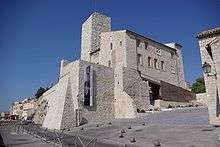
Famous museums include:
- the Maeght Foundation in Saint-Paul-de-Vence
- the Picasso museum in Antibes
- Concrete art in Mouans-Sartoux
- the Fernand Léger Museum in Biot
- the Chagall and Matisse museums in Nice
- the Museum of Modern and Contemporary Art (MAMAC) also in Nice
Education
Primary and secondary education
The department has 222 nursery schools, 357 primary schools and one special school. It also hosts 72 colleges, 14 vocational schools and 22 high schools, to which must be added 65 private schools.
Higher education
The University of Nice Sophia Antipolis, in Nice and neighboring areas, was founded in 1965.
Higher education is relatively underdeveloped in the department. The urban area of Nice has 35,000 students,[24] while Rennes and Bordeaux each have 60,000.
A campus of the Paris Institute of Political Studies (Sciences Po) was established in Menton in October 2005. The Menton campus is dedicated to the relationship between the northern and southern shores of the Mediterranean and the relationship of Europe with the Middle East.
Several engineering schools are also located in Sophia Antipolis:
- Eurecom (School of Engineering and Research Center in communication systems)
- Mines ParisTech
- Polytech Nice Sophia
In addition, two major business schools are located in the region:
- EDHEC in Nice
- Skema Business School in Sophia Antipolis
There are is the French Institute for Research in Computer Science and Automation (INRIA) and the French National Centre for Scientific Research (CNRS) in Sophia Antipolis.
Trivia
The asteroid 100122 Alpes Maritimes is named in the department's honour, on the occasion of the thousandth discovery made from its territory.
See also
Bibliography
- The Heritage of the Communes of Alpes-Maritimes in two volumes, Flohic Éditions, collective work, volume I, Cantons of Antibes to Levens, January 2000, Paris, 504 pages, ISBN 2-84234-071-X, Jean-Luc Flohic (in French)
- The Heritage of the Communes of Alpes-Maritimes in two volumes, Flohic Éditions, collective work, volume II, Cantons of Menton to Villefranche-sur-Mer, January 2000, Paris, 574 pages, ISBN 2-84234-071-X, Jean-Luc Flohic, p. 505 to 1079 (in French)
- Rural Architecture of Alpes-Maritimes, Édisud, Philippe de Beauchamp, 1992, Aix-en-Provence, 140 pages, ISBN 2-85744-612-8, Photographer Loîc-Jahan (in French)
- Religious Art in Alpes-Maritimes, Édisud, Philippe de Beauchamp, 4th Quarter 1993, Aix-en-Provence, 144 pages, ISBN 2-85744-485-0, Photographer Loîc-Jahan (in French)
References
- Inventaire forestier départemental Alpes-Maritimes: IIIe inventaire 2002 [Forest Inventory for the department of Alpes-Maritimes: Third Inventory 2002] (PDF) (Report) (in French). Ministry of Agriculture, Food, Fisheries, Rural Affairs of France. 2004.
- Paris, Nice, Strasbourg, Brest
- Huault, Christian (16 April 2013). "L'intercommunalité en ordre de marche". Nice-Matin (in French).
- (in French) Nice-Côte d'Azur official site
- Site sur la Population et les Limites Administratives de la France
- Almanach Impérial an bissextil MDCCCXII, p. 368, accessed in Gallica 24 July 2013 (in French)
- Table of Results pages 319 to 320 in La réunion de Nice à la France by Paul Gonnet, Les Éditions du Cabri, Breil-sur-Roya, 2003, 343 pages, ISBN 9782914603102 (in French)
- "Charles-Ange Ginésy est le nouveau président du conseil départemental des Alpes-Maritimes". francetvinfo.fr. Retrieved 28 March 2018.
- http://www.assemblee-nationale.fr/
- Budget 2011, Official site of the General Council of Alpes-Maritimes. Consulted on 1 July 2011. (in French)
- Alpes-Maritimes, Le Journal du Net. Consulted on 1 July 2011. (in French)
- Register of Competitivity, 29 January 2009. (in French)
- Legal Populations 2009, INSEE. Consulted on 14 July 2012.
- Municipal Population, legal data of population increases and decreases on 1 January 2012 – Statistical reference date: 1 January 2009, Source: Insee (in French)
- Detailed State Statistical data on births in 2011, INSEE, 2012 (in French)
- The Alpes-Maritimes, much like the rest of the PACA region, is markedly more religious than the rest of France
- Raw GDP data by department (PIB) at current prices, National Institute of Statistics and Economic Studies (Insee) (in French)
- Raw GDP (PIB) at current market prices NUTS 3, Eurostat. consulted on 5 August 2011. (in French)
- 10 French Companies who are World Champions: Alcatel Alenia Space, Le Journal du Net (in French)
- Christian Apothéloz, Alcatel space at Cannes, More than an entreprise, a legend, in The New Economist, March 2002
- INSEE, data from 1 January 2008. (in French)
- "C'est pas classique !" for music-lovers of Nice Archived 7 May 2008 at the Wayback Machine, France Musique website (in French)
- Website of the Conseil général Archived 5 March 2016 at the Wayback Machine (in French)
- Métropole Nice Côte d'Azur – A territory of international excellence Archived 24 February 2009 at the Wayback Machine, Official site of the Urban Community of Nice-Côte d'Azur. Consulted on 26 September 2008. (in French)
External links
| Wikivoyage has a travel guide for Alpes-Maritimes. |
| Wikimedia Commons has media related to Alpes-Maritimes. |
- Alpes-Maritimes at Curlie
- (in French) Prefecture website
- (in French) General council website
- (in English) Musical traditions in the Alpes-Maritimes department
- (in English) About.com
- Archeo-alpi-maritimi (in French)
- Alpes Maritimes, 1450–1550, Altar Pieces and Frescoes (in French)
